
MARCH OF THE TITANS - A HISTORY OF THE WHITE RACE
CHAPTER 4 : THE OLD EUROPEAN CIVILIZATIONS
As the Neolithic revolution became more widespread and larger fixed settlements began to spring up, it became inevitable that these Old Europeans and Proto-Nordic types would start establishing formal societies. The so called "Old European" civilizations then came into being, laying much of the groundwork for the later development of Classical Greece and Rome. Although these Old European civilizations were in fact quite distinct from classical Greece and Rome, they are often mistakenly thought of as one and the same thing.
The original, or Old European settlements, dominated huge areas of Europe and Russia, stretching from Italy right through to the Black sea, including all of modern Austria, Hungary, Bulgaria and part of the Ukraine.
The crucial difference is however that the Old European civilizations were created by the original continental Europeans (Proto-Nordic, Alpine and Mediterranean, with the latter two being in the majority) while the classical civilizations of Greece and Rome received their impetus from Indo-European or Nordic invasions which had started around 5000 BC.
The continental Old European civilizations in the Aegean were the Cretan civilization, centered at Knossos on the island of Crete; the city state of Troy situated adjacent to the Dardanelles in Asia Minor; certain smaller city states on the Greek mainland; and the Etruscans in Italy.
These city states were the first to fall before the great Indo-European invasions, people who had mastered the art of copper working. Absorbed into the Indo-European peoples, the Old Europeans largely disappeared and this mix of White peoples laid the basis for the Mycenean culture which replaced the Cretan civilization as the dominant force in the Aegean.
CRETE - WORLD'S FIRST FLUSHING TOILETS
The island of Crete, situated to the south of Greece, was the home to the Cretan civilization, also known as the Minoan civilization (named after Minos, in legend the most powerful of the Cretan kings).
The original Mediterranean racial composition of this first Cretan civilization has been confirmed by the anatomists Bowdy Dawkins, W.L.H. Duckworth and Felix von Lauschan, all of whom excavated and examined skeletal remains on Crete: their unanimous conclusion was that the Cretans were all members of the (now virtually extinct) Mediterranean subrace. (Race, John R. Baker, Oxford University Press, 1974, page 516).
This skeletal evidence is backed up by the art forms left by the Cretans themselves, particularly in the depictions of social events which are still existent on the walls of the now ruined great Cretan palace at Knossos.

A statue of a goddess from the Old European civilization of Crete. A large number of artifacts such as these have survived in remarkably good condition, affording an excellent opportunity to observe the racial types of the Old Europeans.
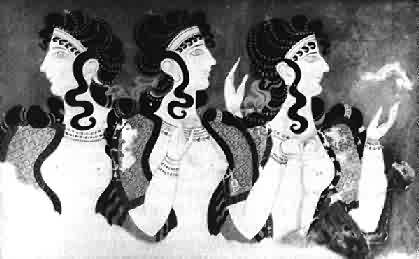
An excellent image of three Old European, or Mediterranean, racial types, taken from a surviving fresco on the walls of the ruins of the palace at Knossos. The links between this ancient civilization and ancient Egypt are confirmed through surviving records and the fact that the artists at Knossos followed the Egyptian convention of painting males with red skins and females with white skins.
By the year 3000 BC, Crete had contact with the budding Egyptian civilization, and many Cretan religious customs and social habits were taken directly from Egypt. Being an island state, it would be fairly logical that the Cretans would possess well developed seafaring skills.
The Cretans were governed by a priest king who had his residence at Knossos. This palace rose several stories high and was the ultimate in luxury at the time.
The city of Knossos itself appears to have been destroyed by an earthquake in 1400 BC - the result of the titanic volcanic eruption which destroyed the neighboring island civilization of Santorini. However, enough artifacts have survived to enable a clear picture of the racial types who inhabited the island to be formed. Most of the walls were of painted plaster, decorated with elaborate frescoes, with the most famous being of a Cretan national sport, "bull jumping" - where brave athletes would grab a charging bull by the horns and somersault backwards over the length of the bull's body.
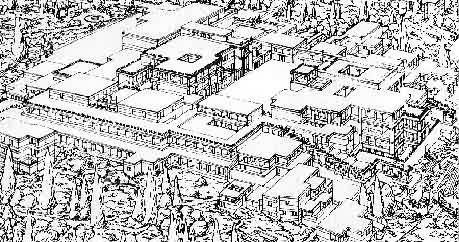
A reconstruction of the palace of Knossos on the island of Crete - a magnificent example of Old European civilization at its height. The palace remains suffered earthquake damage and possible war damage after the Old European civilizations were toppled by Nordic Indo-European invaders. The reconstruction is based on archeological evidence and images discovered on site.
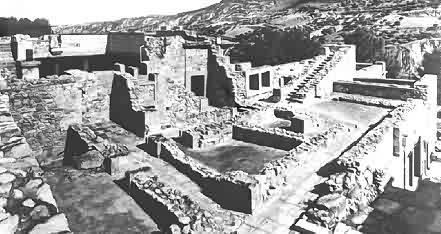
A general view of the site of Knossos as it may be seen today. Knossos was also the site of the legendary Minotaur, or half bull, half man creature in Greek mythology, and of the labyrinth or maze in which the Minotaur lived.
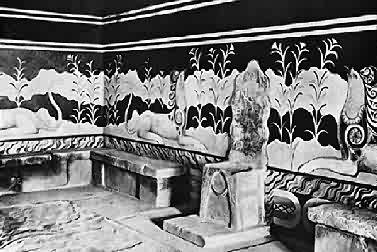
The oldest existing throne in the world - the Throne of Minos, still in its original place in the remains of Knossos, cut out of stone and built into the wall, circa 2000 BC.
Minoan art provides fascinating insights into the nature of the society at the time - men and women dressed for the warm climate, with women bare breasted, and men beardless. Ancient Cretans followed the Egyptian artistic convention of painting males with red skins and females with white skins. Flowers, plants, sea creatures and dolphins feature prominently in their art forms, indicating that their society was advanced and wealthy enough to concern itself beyond just basic survival activities.
One interesting first produced by the Cretan palace of Knossos was the first running water sanitation system - the first "flushing" toilet in the world.
The exact date of the collapse of the Cretan civilization is unfortunately not recorded, but it stopped functioning as a cultural unit when the island was invaded by an Indo-European Nordic tribe, the Myceneans, around the year 1500 BC.
The Cretans were thereafter physically absorbed into the Myceneans, and later became an integral part of the civilization of classical Greece.
In 1900, a British archaeologist, Sir Arthur Evans, rediscovered Knossos and found baked clay tablets with two types of writing, dating from around 2000 BC.
These are called Linear A and Linear B scripts, possibly the oldest identifiable forms of European continental writing (if the "writing stone" found at the Caves of Mes d' Azil in France and the Tatria Tablet from Romania are discounted).

A clay tablet with Linear Script B, circa 1800 BC. Indo-European Mycenean writing found on Crete.
Later research showed that the Linear B script was a form of Mycenean writing, (and which has been deciphered) while the Linear A script was original Cretan (and which has not been deciphered).
TROY - FIRST BUILT 3000 BC
Around the year 750 BC, two great epics, the Iliad and the Odyssey, were set down and attributed to the blind poet Homer. The Iliad describes the war between the Greek city states and the city of Troy, while the Odyssey tells of the adventures of an Ionian king Odysseus, during his return journey home after the war with Troy ended.
For many years the city of Troy was thought to exist only in Homer's poems and was associated with the famous story of the Wooden Horse. The city of Troy was however, actually discovered in 1870 by an amateur archaeologist, Heinrich Schliemann. Instead of discovering just one city, Schliemann unearthed a total of nine cities, all built on top of one another, indicating a whole period of history about which very little is known.
The earliest city on the site dates from about 3000 BC and the various cities (called Troy I - IX) were alternatively destroyed by earthquakes, fire or war, as recounted in Homer's poems. It is difficult to state for certainty how much of the wooden horse story is true (where Greek soldiers are supposed to have infiltrated the city of Troy hidden in a trick wooden horse after unsuccessfully having besieged Troy for nearly ten years) but it is likely to have some basis in fact as Troy and many Greek City States were at war with one another around the year 1,200 BC.
The last Trojan city, number IX, appears to have been a Greek and later a Roman city known as Ilium. As with Crete, the date of the exact end of Troy has also been lost with the passage of time.
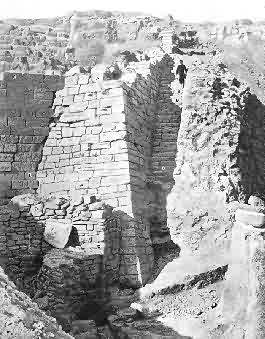
Once thought only to exist in the imagination of the poet Homer, the city of Troy did in fact exist and was discovered by the German archeologist, Heinrich Schliemann. Nine different cities were built on the site, one on top of each other, and very little is known about some of the earliest. The photograph above, shows the main north eastern tower of the sixth city; the steps to the right and the walls next to the steps and at the base of the tower date from the eighth city. The wall at the very left of the picture dates from the city built by the Romans on the spot. Troy was originally founded by the Old European civilizations and was occupied by numerous powers during its history: hence the nine different layers which were found.
Below: A Trojan bowman, carved from marble. A figure on the east facade of the temple of Aphaia, in Aegina, Greece.
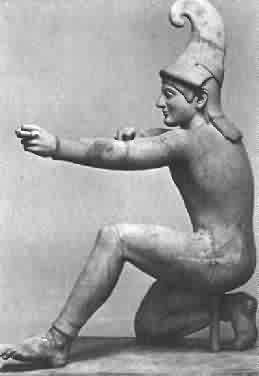
By the time Troy had fallen, the great Indo-European invasions of the Greek mainland had already started, and it is possible that the city itself may at one stage have been destroyed during one of these invasions.
THE ETRUSCANS
The Etruscans became one of the original Mediterranean and Proto-Nordic peoples living in the Italian peninsula before the Indo-European invaders reached that part of the world. Originally called the Villanovans (after a place where they lived), the Etruscans appear to have penetrated Italy from somewhere north of the Alps and seem to have had close contact with some of the Old European civilizations in the Aegean sea, as they adopted Greek characters for writing their language.
Villanovan grave sites have revealed a rich yield of impressive worked metal armor and personal artifacts, some dating from 1000 BC, the time when iron working first became widespread in Italy.
With the advantage provided by iron weapons, the Etruscans quickly subdued other original Mediterranean peoples in Italy, and established a state running from the North in the Po River valley to about a third of the way from the end of the Italian peninsula.
Their most notable achievement was however the settlement of some towns and concentrated urban areas, one of which was later to become the city state of Rome.
An exquisite sculpture, from a sixth century BC Etruscan sarcophagus, is a marvelous representation of the racial characteristics of the Etruscan peoples, who occupied the Italian peninsula before the arrival of the Indo-European Latini tribe. The Latini, who gave their name to the language they spoke, Latin, mixed with the Etruscans and from this combined group came the original Romans.

Etruscan females, illustrations from Etruscan graves at Corneto, Italy. On the left, an original Proto-Nordic Etruscan, on the right, an original Mediterranean type Etruscan.
With the arrival of new invading Indo-European tribes - in this case the most important being the Latini - the Etruscans were absorbed into the new Roman state, with the last official Etruscan king being expelled from Rome in 509 BC. After a few hundred years, the assimilation process between the Etruscans and the Indo-European Latini tribe - the Romans - had reached the point where the Romans offered the Etruscans full Roman citizenship by 100 BC.
By this time the Etruscan heritage had been completely taken up into the new power which was to dominate the known world in a way not seen before: the Roman Empire.
MIDDLE AND NEAR EAST
In addition to the Old European civilizations on the European continent, the Mediterranean and Proto-Nordic sub-racial groupings had by 4000 BC also occupied much of what is today known as the Middle East - from Egypt through to the "fertile crescent", the region between the Tigris and Euphrates Rivers, now lying in modern day Iraq.
These original Mediterraneans were responsible for many of the civilizations in that region. They were subject to almost constant invasion: either by waves of Nordic Indo-Europeans from the north, or by waves of invading Semites, from the south. Sometimes these Old Europeans managed to defeat the invaders, but more often than not they were unable to resist. In this way they were gradually absorbed into the gene pools of their conquerors - these events are reviewed in another chapter.
ANCIENT WHITE CIVILIZATION IN INDIA - THE INDUS RIVER VALLEY
One of the most far-flung of the Old European settlements is to be found centered in modern day northern India. Known as the Harappan culture (after an excavated city, Harappa in modern Pakistan) or the Indus Valley Civilization, it was unknown until 1927 when the first major excavations took place. The remains of settlements belonging to this culture have been found throughout the Indus River valley in Pakistan, westward along the coast to the Iranian border, in India’s northwestern states as far east as New Delhi and on the Oxus River in northern Afghanistan.
OLD EUROPEAN SKULLS FOUND IN INDUS RIVER VALLEY
The Old European - White Mediterranean - racial makeup of the people who created the Indus River Valley civilization has been proven by an examination of skulls and skeletal remains, undertaken by Col. R.B.S. Selwell and Dr. B.S. Guha of the Zoological Society of India, who both conclusively found that virtually all were of the Mediterranean subrace. (Chapter 11, in Marshall, J, Mohenjo-Daro and the Indus Civilization, 1931, London.)
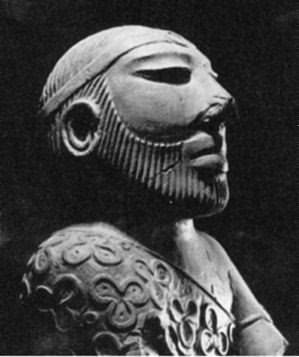
Above: A bust recovered from Mohenjo-Daro showing the racial type of the original inhabitants of this civilization, which extended as far north as the borders of modern day Afghanistan. These White Mediterraneans were absorbed into two sets of outsiders: the non-White dark skinned locals and eventually Nordic Indo-Aryan invaders around 1500 BC. A detailed study of the racial composition of the inhabitants of this region - taken from grave sites - confirms the great mix of racial types and then ultimately the vanishing of the original Old Europeans into this new mixed population.
FIRST WHITE SETTLEMENT CIRCA 2500 BC
The first Old European settlement of the region was made around 2500 BC, when the White Mediterraneans probably arrived after trekking from the Tigris and Euphrates river valley. In the region, they found darker natives, whom they easily subjected. The Old European civilization lasted until the region was invaded by Indo-European Nordics around 1500 BC. The two major cities of the Indus Valley civilization were Mohenjo Daro, in the lower Sind, and Harappa in the Punjab. As a result, the civilization has also become known as the Harappan civilization.
In many respects the cities of the Old European Indus Valley civilization are almost identical to that of other old European civilizations, particularly that at Knossos on Crete. Even the layout of the cities, with their huge square buildings, is identical.
MOHENJO-DARO - THE LARGEST CITY
The major site in this region is the city of Mohenjo-Daro. The remains of this citadel - excavated between 1927 and 1930 - bears huge physical resemblances with the Old European settlements in early Mesopotamia and Crete. At its peak, Mohenjo-Daro must have had over 40,000 inhabitants, a substantial amount for the time. The city was based on an advanced grid plan layout, with streets running in very clearly arranged city blocks.
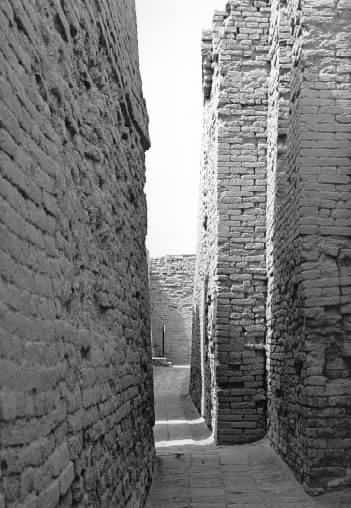
The Old European Indus River Valley civilization. In 1921 the first excavations were undertaken of this White Mediterranean civilization situated in the present day Sind and Punjab regions of India. Settled by Old Europeans around 2500 BC, possibly migrants from the Tigris/Euphrates River area, the greatest city of this civilization was Mohenjo-Daro, whose ruins (above) and water borne sewerage system (below) are architectural wonders.
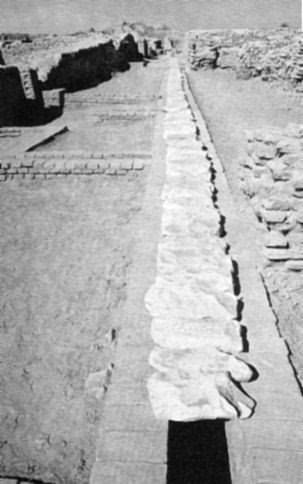
ADVANCED WATER RETICULATED SEWERAGE SYSTEM
The most astonishing aspect of the city however remains the sewerage system - the people of Mohenjo-Daro developed both public and private hygiene to a degree unmatched in many parts of the modern world. Each house, large or small, was provided with earthenware pipe fitted crossways into the walls and opening into a small individual gutter. This in turn, joined central covered sewers. At intervals there were decantation ditches where the main sewers joined. These were designed to collect the heaviest waste so that it would not obstruct the mains.
The houses also all had baths - another innovation for the time - and the water for this purpose was supplied from the many wells throughout the city, some accessible from the streets, and others incorporated into the houses themselves. All the Indus River Valley civilization towns show great building works and an orderly administration built upon an agricultural economy.
Many of the houses were built on mud-brick platforms that protected the buildings from seasonal floods, and multiple story dwellings were common. Other structures include large buildings that may have been used for storing grain and for government. The Old European inhabitants of The Indus River Valley had also developed pictographic writing. A large number of clay seals bearing this language have been recovered, but sadly has never been deciphered.
1500 BC: OLD EUROPEANS ABSORBED INTO DARK NATIVES AND NORDIC INDO-EUROPEAN INVADERS
It is often suggested that the drying up of a major river in North India - the Hakra River - was the cause of the collapse of the Indus River Valley Civilization. This however is not the likely cause of the collapse of the entire culture, spread out, as it was, far further than just around one river.
The real reason for the disappearance of the people of the Indus River Valley is in fact much simpler - like all of the Old European civilizations, the Indus Valley Harappans were to be overwhelmed and integrated into other peoples, be they the dark natives or the new White invaders, the Indo-European Aryans (as detailed in chapter 5).
In this way all the original White Mediterranean civilizations - from western Europe right through to northern India - were all but wiped out through racial assimilation.
or
All material (c) copyright Ostara Publications, 1999.
Re-use for commercial purposes strictly forbidden.